Definition: An Iso-quant curve shows the different combinations of factors of production Viz. Labor and Capital employed to yield the given level of production.
Properties of Iso-quant Curve
- The iso-quant curve is negatively sloped, which means, in order to have a same level of production, the more use of units of one input factor is to be offset with the lesser units of another input factor. This complies with the principle of Marginal Rate of Technical Substitution (MRTP). For example, with more units of capital, the lesser units of labor are to be employed to have a same level of output.
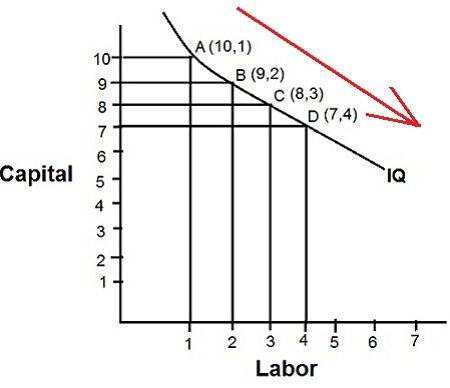 In the figure, it is clear that the reduction in capital is to be set off with the increase in the labor, and thus, the IQ is negatively sloped.
In the figure, it is clear that the reduction in capital is to be set off with the increase in the labor, and thus, the IQ is negatively sloped. - The iso-quant curve is convex to the origin because of the MRTP effect. This shows that factors of production are substitutable for each other and with the increase in one factor the other has to be reduced to have the same level of production.
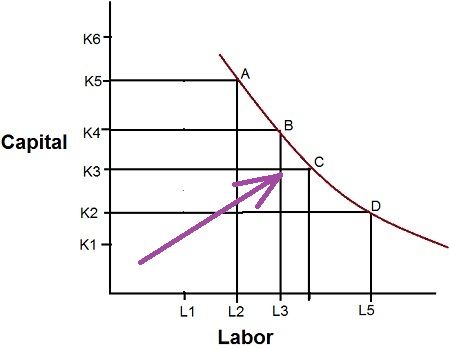
- Iso-quant curves cannot intersect or be tangent to each other. If these intersects, then the results will be incorrect. A common factor combination on both the curves will show the same level of output, which is not feasible.
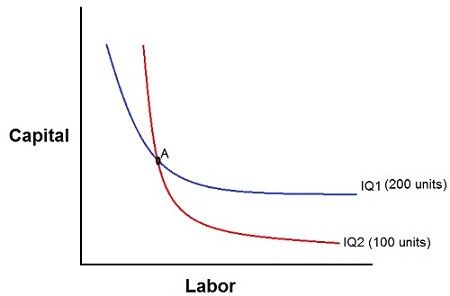
As per the figure, at point A, different combinations on IQ1 and IQ2 produces the same level of output which is not feasible. Since both the curves show different levels of output i.e. 100 and 200 units respectively. - Upper iso-quant curves yield higher outputs. This is possible because, at a higher curve, more factors of production are employed either the capital or the labor, which results in more production.
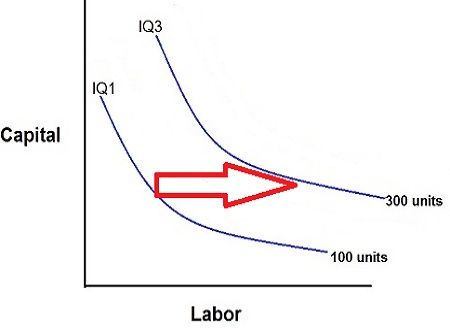 The arrow in the figure shows an increase in the output with a right and upward shift of an iso-quant curve.
The arrow in the figure shows an increase in the output with a right and upward shift of an iso-quant curve. - No iso-quant curve touches either of the axis, X or Y. If it does so, then the rate of technical substitution would be void since it will show that a single factor is producing the given level of output without any units of other factor being employed.
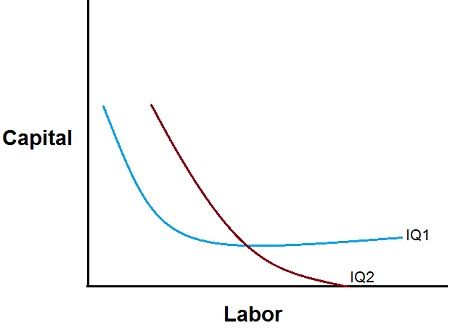 As per the figure, if an iso-quant curve IQ2 touches the X axis, this means no units of labor are employed, and only capital is required to produce the given level of output, which is not correct.
As per the figure, if an iso-quant curve IQ2 touches the X axis, this means no units of labor are employed, and only capital is required to produce the given level of output, which is not correct. - Iso-quant curves need not be parallel to each other because the rate of technical substitution between the factors may vary in all the iso-quant curves.
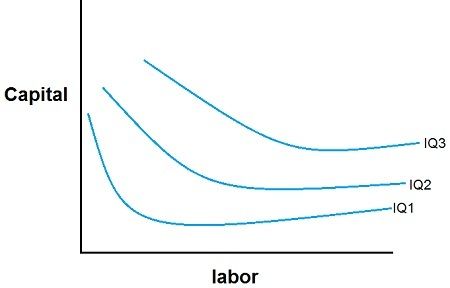
- Each iso-quant curve is oval shaped, which enables a firm to identify the most efficient factor of production.
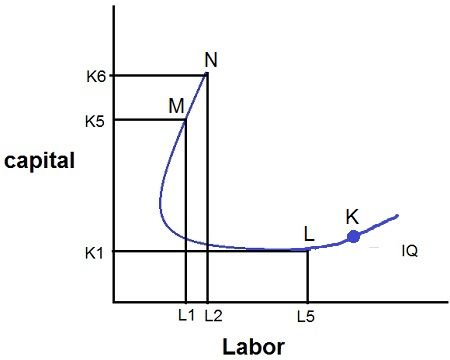 In the figure above, the point N and M shows the same level of output with different combinations of labor and capital. At point N, more capital is employed than labor. Therefore, it is more expensive as compared to the combination shown at point M, where more labor is used as compared to the capital. Similarly, the combination at point K can be ruled out because of the positive slope. Which means that, with an increase in the labor, more capital is to be employed to have a constant production.
In the figure above, the point N and M shows the same level of output with different combinations of labor and capital. At point N, more capital is employed than labor. Therefore, it is more expensive as compared to the combination shown at point M, where more labor is used as compared to the capital. Similarly, the combination at point K can be ruled out because of the positive slope. Which means that, with an increase in the labor, more capital is to be employed to have a constant production.
Hence, it is clear from the properties of an iso-quant curve that a firm can have a same level of production with different combinations of labor and capital that must be utilized in such a way that the overall profitability of the firm increases.

Leave a Reply